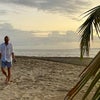Villa Vizcaya, now named the Vizcaya Museum and Gardens, is the former villa and estate of businessman James Deering, of the Deering McCormick-International Harvester fortune, on Biscayne Bay in the present day Coconut Grove neighborhood of Miami, Florida. The early 20th century Vizcaya estate also includes: extensive Italian Renaissance gardens; native woodland landscape; and a historic village outbuildings compound. The landscape and architecture were influenced by Veneto and Tuscan Italian Renaissance models and designed in the Mediterranean Revival architecture style, with Baroque elements. Paul Chalfin was the design director.
Miami-Dade County now owns the Vizcaya property, as the Vizcaya Museum and Gardens, which is open to the public. 'Villa Vizcaya' is served by the Vizcaya Station of the Miami Metrorail.
The estate property originally consisted of Шаблон:Convert of shoreline Mangrove swamps and dense inland native tropical forests. Being a conservationist, Deering sited the development of the estate portion along the shore to conserve the forests. This portion was to include the villa, formal gardens, recreational amenities, expansive lagoon gardens with new islets, potager and grazing fields, and a village services compound. The villa was built primarily between 1914 and 1922, while the construction of the extensive elaborate Italian Renaissance gardens and the village continued into 1923. During the World War I years building trades and supplies were difficult to acquire in Florida. Vizcaya is noteworthy for adapting historical European aesthetic traditions to South Florida's subtropical ecoregion. For example; it combined imported French and Italian garden layouts and elements implemented in Cuban limestone stonework with Floridian coral architectural trim and planted with sub-tropic compatible and native plants that thrived in the habitat and climate. Palms and Philodendrons had not been represented in the emulated gardens of Tuscany or Île-de-France.
Deering used Vizcaya as his winter residence from 1916 until his death in 1925. Paul Chalfin, a former art curator, painter, and interior designer, was the project's director. He assisted and encouraged Deering to collect art items, antiquities, and architectural elements for the project. Chalfin recommended the architect F. Burrall Hoffman to design the structural and envelope of the villa, garden pavilions, and estate outbuildings. The landscape master plan and individual gardens were designed with the Colombian landscape designer Diego Suarez, who had trained with Sir Harold Acton at the gardens of Villa La Pietra outside Florence, Italy. The estate's name refers to the northern Spanish province Vizcaya (In English Biscay), in the Basque region along the east Atlantic's Bay of Biscay, as 'Vizcaya' is on the west Atlantic's Biscayne Bay. Records indicate Deering wished the name also to commemorate an early Spaniard named Vizcaya who he thought explored the area, although later he was corrected that the explorer's name was Sebastián Vizcaíno. Deering used the Caravel, a type of ship style used during the 'Age of Exploration', as the symbol and emblem of Vizcaya. A representation of the mythical explorer "Bel Vizcaya" welcomes visitors at the entrance to the property.
Vizcaya's villa exterior and garden architecture is a composite of different Italian Renaissance villas and gardens, with French Renaissance parterre features, based on visits and research by Chalfin, Deering, and Hoffman. The villa facade's primary influence is the Villa Rezzonico designed by Baldassarre Longhena at Bassano del Grappa in the Veneto region of northern Italy. It is referred to sometimes as the "Hearst Castle of the East".
James Deering died in September 1925, on board the steamship SS City of Paris en route back to the United States. After his death Vizcaya was inherited by his two nieces, Marion Chauncey Deering McCormick and Ely Deering McCormick Danielson. Over the decades, after hurricanes and increasing maintenance costs, they began selling the estate's surrounding land parcels and outer gardens. In 1945 they sold significant portions of the Vizcaya property to the Catholic Diocese of St. Augustine, Florida, to build Miami's Mercy Hospital. Шаблон:Convert comprising the main house, the formal gardens, and the village were retained. In 1952 Miami-Dade County acquired the villa and formal Italian gardens, needing significant restoration, for $1 million. Deering's heirs donated the villa's furnishings and antiquities to the County-Museum. Vizcaya began operation in 1953 as the Dade County Art Museum. The village and remaining property were acquired by the County during the mid-1950s. In 1994 the Vizcaya estate was designated as a National Historic Landmark. In 1998, in conjunction with Vizcaya's reaccreditation process by the American Alliance of Museums, the Vizcaya Museum and Gardens Trust was formed to be the museum's governing body.
The Estate is now known officially as the Vizcaya Museum and Gardens, which consists of Шаблон:Convert with the villa and the gardens, and the remaining native forest. The estate is a total of Шаблон:Convert, of which Шаблон:Convert contain the Italian Renaissance formal gardens, and Шаблон:Convert are circulation and the native 'hammock' (jungle forest). The villa's museum contains more than seventy rooms of distinctive architectural interiors decorated with numerous antiques, with an emphasis on 15th through early 19th century European decorative art and furnishings. Currently owned by Miami-Dade County and governed by the Vizcaya Museum and Gardens Trust (formed in 1998), Vizcaya is located at 3251 South Miami Avenue in Coconut Grove neighborhood of Miami, and is open to the public daily except Tuesdays, Thanksgiving, and Christmas Day. It has accreditation by the American Alliance of Museums.
Vizcaya was built with an open-air courtyard and extensive gardens on Biscayne Bay. As such, the estate has been subject to environmental and hurricane damage, the latter notably in 1926, 1992, and 2005. Miami-Dade County has granted money ($50m U.S.) for the restoration and preservation of Vizcaya. These funds have been matched by grants from FEMA, Save America's Treasures, and numerous other funders. Plans include restoration of the villa and gardens, and adaptation of the historic village compound for exhibition and educational facilities; however, additional funds are required for this. The completed first phase of this project has included rebuilding of the museum's Cafe and Shop (in historic recreation areas of the building adjacent to the pool), renovation of the East and West Gate Lodges that flank South Miami Avenue, and rebuilding of the David A. Klein Orchidarium in a plan that generally uses historic precedent. At the same time, Vizcaya has completed the first half of a major conservation program of its outdoor sculpture collections. With a consulting landscape architect, Vizcaya has too finished a comprehensive cultural landscape report, which will be a vital tool in the ongoing restoration of the formal gardens.
In 2008 the National Trust for Historic Preservation listed Vizcaya as one of America's Eleven Most Endangered Historic Places. As noted by the National Trust's website, Vizcaya's inclusion on this list was based on the threat of proposed highrise development on neighboring property. Specifically, the National Trust stated: "Unless development is blocked or an intervention occurs, this cultural landscape will be permanently damaged by the construction of three high-rise condominium towers within Vizcaya's historic viewshed." The proposed highrises were blocked by two court rulings and in 2010 the City of Miami included viewshed protection for historic properties like Vizcaya in its new zoning code, "Miami 21."
Other types of events are hosted by the museum to collect funds for its preservation. For example, every Halloween, Vizcaya organized a costume party, where people from all around Florida attend with their creative costumes. The cause of the event is to preserve and protect one of the jewels of South Florida.
Vizcaya was the 1987 venue where President Ronald Reagan received Pope John Paul II on his first visit to Miami.
Vizcaya was the 1994 location of the important 'First Summit of the Americas' convened by President Bill Clinton. This began a series of Summits of the countries in The Americas. The thirty-four nations' leaders that met at Vizcaya created the 'Free Trade Area of the Americas (FTAA),' that all the hemisphere's countries, except Cuba, could join for national and corporate trade benefits.
Vizcaya has provided the setting for many films, both credited and uncredited. Deering himself enjoyed watching silent films in Vizcaya's courtyard, and he had a particular interest in the works of Charlie Chaplin. External pictures of Villa Vizcaya, for example, can be seen in the films Tony Rome, Ace Ventura: Pet Detective, Any Given Sunday, Bad Boys II, Airport '77, Haunts of the Very Rich, The Money Pit, and Iron Man 3. The music video for The Cover Girls' song "Promise Me" from 1988 was filmed at Vizcaya. The music video for New Edition's song "I'm Still In Love With You" from 1996 was also filmed at Vizcaya.
Vizcaya is also an extremely popular location for weddings and other special events, given the site's architectural and natural beauty. For decades, the estate has been a target of photography, and is a favored site for photographs of women celebrating their quinceañera (15th birthday).
On April 18, 2012, the AIA's Florida Chapter placed Vizcaya on its list of Florida Architecture: 100 Years. 100 Places.





